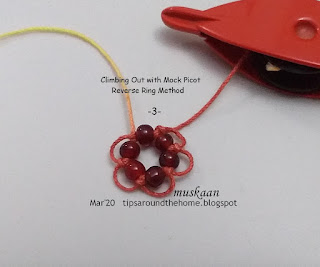A
few eager tatters had requested the diagram-only pdf which I sent privately and Usha Shah’s
lovely rendition in metallic thread has already reached my inbox.
Finally,
after a lot of self-editing over several evenings, the pattern is ready to be
published.
I
had started it in Anchor size 20, in single colour above. But it was turning out so large, hence stopped and switched to Anchor Pearl cotton size 8 in 2 colours
and reduced the count as well.
Instead
of the pattern in my deconstruction series, I used the concept shared by Halibut04. It eliminates the central picot and rings are linked on either side.
And
using only 2 decorative picots for the inner chains – this idea is taken from
this exquisite Japanese Tatting Square Doily.
Huguenot
Cross Pendant
 The
square in the center kept looking like a emblem or insignia, except I didn’t
know where to start my search without a term. Fortunately when I accepted someone’s fb request, there it was
in bobbin lace – Huguenot Cross! What a huge coincidence.
The
square in the center kept looking like a emblem or insignia, except I didn’t
know where to start my search without a term. Fortunately when I accepted someone’s fb request, there it was
in bobbin lace – Huguenot Cross! What a huge coincidence.My intention was to have 2-coloured split rings all around. At the last moment I switched to a black chain edge so that the blue ring clusters look complete. This, unfortunately, decreased the indent. I do want to try the SR one later to highlight the Maltese Cross.
There
are a lot of symbols within this cross (heart, fleur-de-lis, Maltese cross, 8 Beatitudes, dove), some of which are recreated in a stylised form. Since I don’t have any dove charm or sequin, a
butterfly sequin is used at the base, and converted into a pendant. Hope there is no religious sentiment being hurt.
The Josephines are 8 half-stitches and extra chains are 5 or 6ds.
The Josephines are 8 half-stitches and extra chains are 5 or 6ds.
A Tiger Face? Perhaps a butterfly!
Wondering how only chains would look, for a deeper notch, I started another in green/black. Midways, it started looking like a butterfly, and then like the face of a tiger (focus on the negative space enclosed by the black chains above - they look like eyes and the rest of the facial features magically emerge)!
There were 2 green rings where the top picots are. I had to untat one, and snip off the other and reattach black thread to make it symmetrical. Want to see how it looks after I complete a long black chain outlining the top of the head.
So
many possibilities! If you wish to play, check out the ideas in this series - Part 1, Part 2, Part 3! Derivative patterns that have already been shared include heart,
bracelet, and bookmark.
Magic Square Cross pattern. Click to download the pdf.Best wishes ....






































